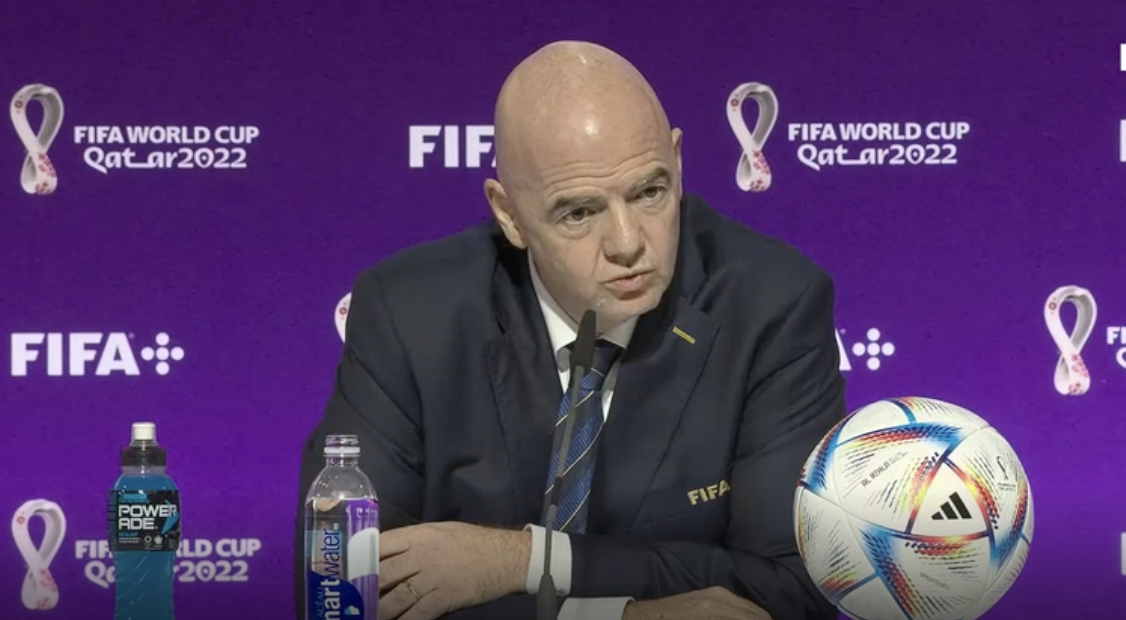By David Owen
November 23 – So, what do you know: 55 minutes into that extraordinary hour-long tormented, angry pre-World Cup vent by FIFA President Gianni Infantino, some hard, or hard-ish, financial information.
It seems worth dwelling on it here, since by that point in proceedings his distinguished 400-strong global media audience had enough material for a dozen stories, and may no longer have been giving world football’s boss their fullest attention.
The information came in three parts.
First, in spite of all the criticism, media rights for Qatar 2022 had fetched around $200 million more than the last World Cup. Second, sponsorship rights had similarly yielded some $200 million more than Russia 2018. Third, as far as ticketing and hospitality rights are concerned, Infantino said, “we are at almost $200-300 million more than the last World Cup”.
So, while the present tournament looks likely to do little to burnish FIFA’s tarnished image, at least in Europe, still the unchallenged epicentre of the world’s biggest sport, at least all is rosy in the Zurich body’s financial rose-garden, right?
Well, let’s consider that, always bearing in mind that these are not audited figures, but guidance offered almost as an afterthought to a rhetorical outpouring that even Infantino’s predecessor Joseph Blatter would have been hard-pressed to match.
One has to be slightly careful, since FIFA does have other revenue sources and tends not to offer neat, tabulated summaries of how much successive World Cups earn from their various income streams.
However, we do know from the body’s 2018 annual report that Russia 2018 generated $5.36 billion of revenue. Broadcasting rights for the cycle brought in $3.13 billion, with that World Cup said to have contributed 95% of the total, so about $2.97 billion.
The $200 million jump alluded to by Infantino would then amount to around 6.7% growth – not bad, especially as this year’s tournament is at an unusual time of year and somewhat more condensed than usual, but far from earth-shattering.
It looks like the fastest Qatar 2022-related growth will be down to ticketing and hospitality. This was put at $689 million four years ago, so the top of the FIFA President’s $200-$300 million range would equate to an improvement of some 43.5%. Even the bottom of the range would amount to a 29% advance.
Then again, growth from this revenue source was relatively sluggish between 2014 and 2018, with Brazil 2014 seemingly generating $185 million from hospitality and $476.6 million from ticketing, so a stronger performance this time around was probably to be expected, especially given the reservoirs of wealth in the Gulf region.
As for sponsorship, this has been really in the doldrums in the wake of the tumultuous and reputation-shredding end of the Blatter era. Marketing generated $1.66 billion of revenue in 2015-2018, the last completed World Cup cycle, barely changed from the $1.63 billion earned in 2011-2014. So a $200 million jump – a 12% gain – seems at least mildly encouraging.
Set against the growth in sponsorship revenue attained by the International Olympic Committee, the other sports mega-event owner, in recent times, however, FIFA’s record looks less than impressive, especially when the 2011-2014 cycle is taken into account.
Another benchmark for FIFA’s performance is the rate of growth attained by UEFA, the European football body, whose exposure to the glitzy elite club game is far greater.
Breaking down UEFA’s record over the past 12 financial years for which numbers are available into three stretches of four years, for purposes of comparability, its aggregate revenues have more than doubled, from €7.27 billion ($7.44 billion) for 2009/10 to 2012/13 to €15.41 billion ($15.78 billion) for 2017/18 to 2020/21. Its revenue for 2020/21 alone reached €5.72 billion ($5.86 billion).
Over a slightly different span, FIFA’s quadrennial revenue has climbed from $5.72 billion in 2011-2014 to $6.42 billion in 2015-2018 to something like $7.5 billion in 2019-2022, if a tweet from a usually ultra-reliable New York Times journalist is to be believed.
Those numbers would make most sports bodies green with envy. But they add up to growth of only about 31% over the two cycles, versus just under 112% for UEFA.
The conclusion Infantino drew after revealing the new FIFA figures was that “if so many people around the world are investing so much money in the World Cup in Qatar, they invest because they believe in FIFA”.
He went on: “They saw what FIFA has done to clean up the organisation, to make progress in the football areas and also in the social field. And also because they trust Qatar: they know that they can come here, they know they can enjoy, they can celebrate and that they can expect a great World Cup.”
And then the pay-off line: “Either all these people are stupid, or somebody of those who say that nobody will watch this or nobody cares about this World Cup might be a little bit wrong, as some of the polls in some elections in some countries were wrong as well.”
Top-level competitive football sells like few other things in sport; we know that. But a prospective 31% rate of top-line growth for FIFA across two cycles against 112% for another body which benefits from the skills of many of the same stars.
That is quite a performance gap. There is still, it seems, ground to make up for FIFA.
Contact the writer of this story at moc.l1745210024labto1745210024ofdlr1745210024owedi1745210024sni@n1745210024ewo.d1745210024ivad1745210024

